Calculation of ventilation in a private house calculator. Do-it-yourself ventilation in a private house: scheme, proper preparation and implementation of the project
One of the most important indicators determining the degree of comfort of housing is a favorable microclimate, which directly depends on the quality of indoor air and ventilation. That is why proper and thoughtful ventilation of a private house will improve the quality of life and create a healthy atmosphere.
How to do the ventilation of a private house with your own hands?
For the manufacture and installation of a ventilation system for a private house, it is necessary to decide which system is most effective for a given building.
Important! If the building has small dimensions and the number of people living in it is small, that is, its area does not exceed 200m2, and the number of residents is not more than 5-6 people, then it is used for ventilation with natural draft.
In other words, the project provides for ventilation ducts that produce air exchange due to the laws of physics, which force warm air masses to leave the room, rising up, and cold air to enter the building through window and door openings. In this case, additional ventilation equipment is not provided, which significantly saves the developer's money, but does not exclude the ingress of foreign odors and various microelements and dust along with outdoor air. The efficiency of work in this case will significantly depend on weather conditions and climatic features of the construction region.
A supply system is often used, which involves pumping outside air into special filters. After cleaning, the air is heated to the required temperature, its humidity is adjusted and supplied to the premises.
The exhaust system is similar to the supply system, with the difference that the pump does not supply outside air, and removes air from the premises to the street through the ventilation shafts.
The most suitable for modern houses with an area equal to 300 - 500 m2 is a ventilation system that combines the properties of a supply and exhaust with a heat exchanger. In other words, a system is being created that fully regulates the supply of air, its processing and distribution to the premises of the house, the removal of exhaust air to the outside and a partial mixture of warm air with outdoor air (recovery) to reduce the cost of heating it.
After choosing a ventilation system for a private house, it is possible, based on the calculations made, to purchase materials and install equipment. The most rational thing would be to fix the main exhaust pipe on one of the internal load-bearing walls, and from it to separate the ventilation ducts throughout all the premises of the floor. The material of pipes for ventilation ducts can be very diverse. Do not forget that in the very recent past they were knocked down from wooden boards, and today plastic pipes have become the most practical material. Their weight allows the pipes to be fixed in any convenient place, they are not subject to corrosion, they are easy to install, and they are relatively cheap.
The market offers huge selection filters, but it is most rational to use combined filters consisting of two components - for dust particles and for gases. They do not allow airborne particles, smog odors, decaying organic particles, food and smoke odors to enter living spaces.
Of all the types of recuperators offered by manufacturers for the ventilation of a private house, a plate-type heat exchanger is the most suitable. It is very easy to install, which will allow you to do all the installation work yourself, a simple design and the absence of dynamic loads from rotating or moving parts eliminate breakdowns, does not require power supply and has excellent efficiency.
Heaters for ventilation of a private house must be selected in such a way that they provide the required design temperature of the supplied air and are sufficiently economical in energy consumption. Not only electricity, but also natural gas can serve as power, which will help save costs for the maintenance and operation of the entire system.
The place for the installation of fans can serve as an attic or technical floor. The main indicator of fans is its power, which is determined by calculation. When choosing, special attention should be paid to noise indicators.
When installing the ventilation system of a private house, you need to think about how it will be decorated. The best option would be to hide all ducts and equipment above the ceiling. If the house has several floors, then you can use suspended ceilings such as "Armstrong". At the right combination ceiling elements and diffusers, they can give the room style and originality.
Calculation of ventilation of a private house

Diagram of a ventilation device with a heater
Only a qualified engineer can perform an accurate calculation of the ventilation system, but any educated person can calculate the ventilation of his small house.
Let's take the following performance characteristics for calculation:
- The area of living rooms is 100 m2;
- Kitchen area - 20 m2;
- Bathroom and toilet area - 10 m2;
- Wardrobe area - 10 m2;
- Other premises - 40 m2;
- Floor height - 3 m.
We determine the required performance of the ventilation system
It is calculated based on the required air exchange in the premises of the house. So in living rooms, air exchange is 3 m3 / h per 1 m2, in the bathroom 25 m3 / h, in the kitchen the air exchange rate is 6, i.e. we multiply its area by the height of the room and by the multiplicity, in the dressing room the multiplicity is 1.5, in other rooms 1.
We calculate the performance:
100x3+25+20x3x6+10x3x1.5+40x3x1=850 m3/hour
Calculation of heater power
To select a heater, we calculate its power.
To do this, we multiply the difference in air temperature at the inlet and outlet of the heater (for the Moscow region it is 44 ° C) by the previously obtained productivity (850 m3 / h) and the volumetric heat capacity of the air (0.336 W * h / m3 / ° C), and then the obtained divide the value by 1000.
44x850x0.336/1000=12.57 kW.
Based on the received power of the heater, it is possible to perform a calculation and determine the power of the current necessary for its operation. To calculate, you need to decide what current will be used to power the unit - single-phase or three-phase. We accept single-phase current with a voltage of 220V as a power supply.
12570/220=57 A
Attention! The resulting current strength will significantly load the electrical network of the house, provided that single-phase power is used.
Selection of the section of air ducts for ventilation of a private house

Air ducts for ventilation
We determine the cross-sectional area of the duct by multiplying the system capacity (850 m3 / h) by a factor of 2.778 and dividing by the air speed, which is assumed to be 5 m / s.
850x2.778/5=472.26 cm2
Since it is supposed to use a plastic pipe as an air duct, we calculate its diameter, which is equal to the square root of the product of the area (472.26 cm2) by the constant 400 and divided by the number pi (3.14).
√472.26x400/3.14=245.28mm.
Since pipes with such a diameter are not produced, we accept a typical pipe d = 250mm. At an air speed of 5 m/s, a pipe with a diameter of 250 mm provides a capacity of 900 m3/h, i.e. its application completely provides ventilation of the house.
Ventilation of a private house should be based on the calculation and proper selection of materials.

The ventilation system in a private house plays an important role in creating a favorable microclimate in the home, ensuring comfortable living for people. With its help, oxygen enters the house, polluted air is removed, and the temperature and humidity of the air that the residents need is maintained. For effective operation, it is necessary to correctly calculate the main parameters of the system, as well as high-quality installation of ventilation in a private house and setting up all its main components.
Choosing the type of ventilation for a private house
The ventilation device in a private house provides for several successive stages, of which the main one is the choice of the type of ventilation. It depends on many different factors, including:

- at what stage the installation of the ventilation system is carried out - during the construction of a new house, or already in a built dwelling;
- type of building materials from which the house is built (brick, foam concrete, wood, etc.);
- the total area of the house and the volume of each individual room;
- financial capacity of the owner of the house.
Ventilation systems that are usually used in a private house can be of two main types:
- natural ventilation, the advantage of which is the simplicity and low cost of its installation and operation, no need to install additional equipment and its Maintenance. However, such a system cannot function in houses with high airtightness, in large rooms and is largely dependent on climate and other natural phenomena (outdoor temperature, wind, etc.). In addition, its operation often requires the use of large ventilation openings and increased diameters of air ducts, which is not always possible, especially in an already built building.
- Forced ventilation, in which air circulation is carried out due to the operation of exhaust and / or fans sucking in outside air. It can be: exhaust, supply, balanced (supply and exhaust), as well as a system with recuperation (heat recovery). Such systems can provide complete control of the ventilation system, filtering the intake air, regulating the required temperature and humidity in the room, saving the cost of heating the house. At the same time, the disadvantage of these systems is the rather high cost of equipment, the relative complexity of installation and maintenance, as well as the additional consumption of electricity.
Ventilation system design

After the type is defined ventilation system, it is necessary to design ventilation in a private house, determining all the necessary elements of the system and their relative location for each individual room and throughout the building as a whole. In this case, special attention should be paid to domestic and technical premises (kitchens, bathrooms, boiler rooms, etc.), where the most intensive air ventilation is required.
For a house under construction, it is best to include the ventilation project of a private house in the overall project of communications of the future building, providing for the location of ventilation ducts built into the walls and technological openings for air inlet and outlet, as well as installation sites for additional elements.
When developing a system natural ventilation it must be borne in mind that the ventilation scheme in a private house should provide for the location of the outlets of the exhaust ducts above one meter above the level of the roof of the house, and the distance from the inlet to the outlet exhaust grille should be 5-6 meters. This ensures the creation of the necessary draft in the exhaust air ducts and contributes to effective work the entire system.
Laying ventilation in a private house should be carried out in such a way as to ensure minimum dimensions the length of the air ducts, the least number of their bends and other possible obstacles that prevent the free passage of air flow through them.
Calculation of the ventilation system
The calculation of the ventilation system of a private house is based on determining the required air exchange in each room of the house, measured in cubic meters per hour. To make such a calculation, a complete floor plan is required, indicating the area and purpose of each room in the house. Definition required amount Air exchange in a separate room is carried out in two main ways:
- Taking into account the coefficient of air exchange, which is multiplied by the volume of the room. This coefficient depends on its purpose and is equal to "1" in living rooms (bedroom, living room) and "3" in household rooms (kitchen, bathroom, etc.). For example: in a bedroom with an area of 20 sq.m and a ceiling height of 2.5 m, the amount of air exchange should be 50 cubic meters per hour (20x2.5x1); in the kitchen, with a size of 10 sq.m and the same ceiling height, taking into account a three-fold coefficient - 75 kbm / h (10x2.5x3).
- Taking into account the number of people present in the room. The standard for air consumption by one person, according to sanitary and hygienic rules, is: for a bedroom - 20 kbm / h, for other residential premises (living room, children's room) - 40 kbm / h, for the kitchen and other household premises - 60 kbm / h. Thus, in a bedroom for two people, the required air flow will be 40 kbm / h (20x2), for a kitchen in a house where 3 people permanently live - 180 kbm / h (60x3).
The scheme of the ventilation system of a private house should provide the house with such a volume of fresh air that corresponds to highest value calculated using these two methods.
After that, it is necessary to calculate the parameters of individual elements of the ventilation system: the type and required size of the through holes of the supply and exhaust devices, the diameter of the ventilation ducts, the power of the fans (for a forced ventilation system).
Proper organization of ventilation in a private house depends on the type and diameter of the air ducts of the ventilation ducts. They can be built into the inside as a shaft in the wall or installed outside in the form of metal or plastic pipelines of round or rectangular cross section. To make channel bends and connect various ventilation equipment, corrugated pipes. In unheated rooms and outside the house, the air ducts are insulated to prevent the formation of condensate inside the pipes. A special deflector in the form of an umbrella is installed at the outlet of the exhaust channel so that atmospheric precipitation and foreign objects do not get inside.
When calculating ventilation in a private house, it must be taken into account that the diameter of the ventilation ducts must provide the necessary pressure and air flow rate to create the required amount of air exchange in the room. For example, in order to ensure air exchange in the room in the amount of 300 kbm / h, a channel section of 250x400 mm is required with natural ventilation or 160x200 mm with a forced system. The minimum allowable diameter of the ventilation duct for natural ventilation must be at least ten centimeters, for forced ventilation systems - from 6 cm.
Ventilation in a private house, the price of which directly depends on the type of system chosen, can be designed and installed independently or by specialists in this field. In any case, it is better to entrust the verification of the correctness of the scheme and calculations of the parameters of the ventilation system to a person with relevant knowledge and experience.
To ensure a normal life in a private house, the ventilation system must work reliably in it. It is not only designed to remove unpleasant odors and soot from the premises, but also to provide people who are in the house with an influx of fresh air. It is necessary to think about the design and installation of an air exchange system at the stage of building a house. How to make ventilation of a private house with your own hands - later in the article.
In order to organize high-quality air exchange indoors, you should choose the right type of ventilation, the equipment used, the power of the devices. Depending on the specifics of the work, there are three types of ventilation in the house:
- Natural air exchange. Based on the principle of basic air movement. As you know, warm air is lighter in density, therefore it accumulates in the upper part of the room. Cold, on the contrary, is concentrated from below. Natural ventilation ducts are located under the roof of a private house in such a way that cold air naturally pushes warm air out of the room. The full operation of such a system is possible in such a case when the air temperature in environment does not exceed 15 degrees and is not below 5 degrees. When the temperature drops, drafts and strong gusts of wind can form through the ventilation openings. At elevated temperatures, on the contrary, the intensity of air exchange decreases, and the system becomes inefficient.
- Forced air exchange. The main element in this system are auxiliary mechanical devices that regulate the supply of fresh air and the outflow of stagnant air. Such elements are - fans, air conditioners, heaters, cleaning filters, etc. With the help of these devices, air moves through the air channels, so that the room always remains ventilated.
- Mixed air exchange system. In this ventilation system, there is a combination of natural and forced ventilation elements. For example, fans and exhaust systems(for example, in a bathroom, in a kitchen room), in the rest of the rooms of the house, ventilation is arranged according to the natural type.
Calculation of ventilation in a private house

In order for the ventilation in a private house to work correctly and perform all its functions, it is necessary to calculate the air ducts and correctly determine their installation locations.
The minimum allowable duct diameter for a private house is 150 mm. A pipe of this diameter has a cross-sectional area of about 0.015 m 2, which is quite enough to ensure normal air circulation. For rectangular ducts, the wall length must be at least 100 mm. With a ventilation duct height of 3 meters, through natural ventilation, only 30 m 3 of air passes through it in 1 hour, which is equivalent to 1 room with a ceiling height of 3 meters and an area of 10 m 2. Naturally, this is not enough. To increase the air circulation rate, two methods are available:
- Increasing the height of the channel.
- Increasing the cross-sectional area of the channel.
With a ventilation duct length of 2 meters or less, there will be no natural draft. The ventilation performance is also affected by the configuration of the roof, the number of floors of the house, the absence or presence of an attic.
If it is planned to build two or more ventilation ducts in the building, their height and cross-sectional area must be the same. Otherwise, the thrust will noticeably decrease. Also, do not hang the entire wiring of horizontal ducts around the house on one vertical ventilation duct. In this case, the thrust will noticeably decrease.
The calculation of the performance of the ventilation duct is made depending on its cross-sectional area, height and internal temperature in room. Thus, with a cross-sectional area of 0.024 m 2 , a height of 2 m and a room temperature of 16°C, the system performance is 24 m 3 /hour. Whereas at a height of 10 m and a temperature of 32 ° C, its productivity increases by 5 times.

To calculate the performance of the ventilation system in a private house, the air exchange rate is used. This indicator is derived empirically and shows how many times in 1 hour the air should be changed in a particular room.
System performance (PS) will be equal to:
- PS \u003d OP (room volume) x PC (multiplicity index)
The multiplicity index is specified in SNiP 2.08.01-89* "Residential buildings". So, for a common room or bedroom, this coefficient is 1. This means that for normal air exchange in a room measuring 15 m 2 with a ceiling height of 3 m, the system performance must be at least 45 m 3 / hour. Now you need to calculate the performance for each individual room in the same way and sum them up. After that, knowing the performance of 1 channel (which depends on its height, section and room temperature), you can calculate their number.
For example, the required air circulation in the house is 250 m 3 / hour. The height of the channel is 4 meters, and its cross-sectional area is 0.024 m 2 . Then its average productivity will be approximately 53 m 3 /hour. Accordingly, for normal air exchange in the house, 5 such channels are needed.
This is a fairly simple calculation that does not take into account the aerodynamic resistance in the pipe, the effect of the wind rose and their speed on the air flow velocity in the channel, however, it can give a simple idea of what should be proper ventilation in the house.
Exhaust ventilation installation technology in a private house

After the system is calculated, you can begin to select the types of ducts for exhaust and devices for air supply.
In order to optimally select the configuration of ventilation pipes, as well as the material of their manufacture, it is necessary to know their properties:
- The shape of the air ducts is different, but most often they use round and rectangular channels. The first is most often used in production and left open for reasons of practicality. In civil engineering, air ducts are made of rectangular section and hidden in special niches. Since they are quite noisy, a layer of sound insulation is equipped for them.
- Manufacturing material. Channels can be laid out from various building blocks, mounted from galvanized rolled steel, or plastic. Quite often, corrugated ducts are used in forced ventilation systems. Their great advantage lies in the fact that they can be mounted in places where channel bends are required. However, the corrugated structure causes a decrease in traction, so they are not suitable for natural ventilation. Plastic air ducts are not afraid of temperature changes, therefore they practically do not create condensate. Because of this, they do not need to be insulated. However, their disadvantage is that static voltage is created on their surface, due to which a layer of dust accumulates on the walls. It is also worth noting that plastic is a material that supports combustion, so you need to handle it carefully.
- When installing ventilation ducts exhaust ventilation it is necessary to take into account the configuration of the roof, namely, the angle of inclination of the slopes, as well as the location of the outer part of the duct relative to the ridge. The closer it is to the ridge, the higher the outer part should be.
Installation of supply ventilation in the house

For normal ventilation of the premises, not only the outflow of air is necessary, but also its inflow. For this use ventilation valves. They are installed both on the windows and on the walls of the room.
Installing a window inlet valve plastic window- the case is quite simple and does not require special skills. In this case, there is no need to make any changes to the design of the frame and sashes. The valve itself is sold ready-made with a set of seals, and all that is required for its installation is simply to install it on the opening leaf.
For this you will need:
- Roulette.
- Stationery knife.
- Pencil.
- Screwdriver or screwdriver.
Work order:
- The first step is to remove the section of the seal on the window frame against which the sash is pressed. It is better to remove the central part. The length of the segment must be equal to the dimensions of the seal from the valve kit. If its length is 350 mm and the width of the frame is 550 mm, then it is necessary to measure 100 mm from each side and make cuts with a knife.
- After that, the inner segment is removed and a seal from the kit is installed on it. Unlike the standard one, this seal can allow air to pass through, which will ensure its flow into the room. It is installed very simply in the groove.
- Further, on the frame on the inside of the window, marks are made opposite an even seal. The sash is then tightly closed and the label data is transferred to it.
- After that, the section of the seal on the sash should be removed, strictly opposite the seal on the frame. In its place, caps are installed for tightening the screws. They move freely along the groove and must be installed exactly in the positions of the holes on the valve body.
- On the valve body there is a strip of double-sided tape, with which it is glued to the upper end of the leaf. After that, it is fixed with screws.
- There is a lever on the valve panel, the movement of which closes it or opens it.
Installation wall valve produced as follows:
- A hole of the appropriate diameter is knocked out in the wall.
- Then you need to disassemble the valve.
- The case, which will be inserted into the wall, is wrapped in a heat-insulating layer, if it is not provided by the manufacturer.
- Further, the case is mounted inside the wall with a slight slope outwards. This is done so that the condensate that forms inside flows out, and precipitation does not get inside.
- The damper and filter are installed on the valve, and its body is fixed in the wall. Outside, a ventilation grill for a private house is installed.
Ventilation scheme in a private house: photo



Ventilation in a private house: video
The supply of fresh air is needed to ensure healthy living conditions, good plant maintenance and quality functioning. technical systems. At the same time, it is necessary to remove various harmful impurities. Do-it-yourself productive ventilation in a private house will help to solve these problems in a complex. Scheme, calculations, installation methods - all this in today's review.
A good ventilation system is an indispensable element of the engineering equipment of a modern private house.
Modern buildings are created with improved indicators of tightness of window and door blocks. This improves economic performance during operation, but blocks the access of fresh air. This example explains the need for an integrated approach when considering the functionality of engineering systems.
It is also necessary to note the following features for the correct formulation of requirements for good project ventilation of a private house:
- The composition of the atmosphere in the room can change the state of the air outside, the presence of sources of harmful and unpleasant impurities in the property itself.
- Ways to control heating, air conditioning, ventilation are essential.
- It is possible that contaminants from household chemicals, finishing and building materials can enter the air environment.
- To calculate the ventilation device in a private house, you can apply the methodology for taking into account the maximum permissible concentrations of impurities, or indicators of normal air exchange.
- We must not forget about the different needs in and in the kitchen, in the training room and living room.
- Boilers, gas stoves and other equipment actively consume oxygen.
- It is necessary to take into account the individual physiological characteristics and preferences of users. Particular attention should be exercised in the presence of allergic reactions.
It should be emphasized that the current domestic and foreign regulations, industry and sanitary and hygienic standards contain conflicting data. The above information explains the actual complexity of the task. Too many factors affect the parameters of indoor air. In addition to objective indicators, individual preferences will have to be taken into account.
For your information! For residential premises, the multiplicity of the complete exchange is calculated using the proportion of 30 cubic meters. m. per hour per person. Below are the corrective data for different rooms and special operating conditions.
That is why, when performing calculations for installing ventilation in a private house, experienced specialists make a sufficient margin for performance. It helps to make the necessary corrections at peak loads.
Types of ventilation systems
The supply of fresh air to the premises is organized constantly. Only the intensity of the corresponding operations changes. This means that the most convenient and economical system is the one that performs its functions without close monitoring and energy consumption. On the other hand, the use of forced mechanisms simplifies the ventilation of rooms.
Advantages and disadvantages of natural ventilation in a private house

On this simplified diagram of natural ventilation in a private house, the main parts of an engineering structure are indicated. Here, holes are made in the walls through which air from the street enters. Paths have been created for free movement of flows between rooms, outlet channels.
To ensure air exchange according to the above standard (30 cubic meters per person per hour), it is enough to install an inlet and outlet pipe with a diameter of 150 mm or more. The height of the vertical part is made from 300 cm or more. This typical example can be used for calculations taking into account the architectural features of the property.
Important notes:
- The same length of vertical pipes will equalize.
- The efficiency of the system is reduced by: branches, horizontal sections, changing the section.
- For ease of construction, channels from rooms on different floors are combined in a single ventilation shaft, or mounted side by side.
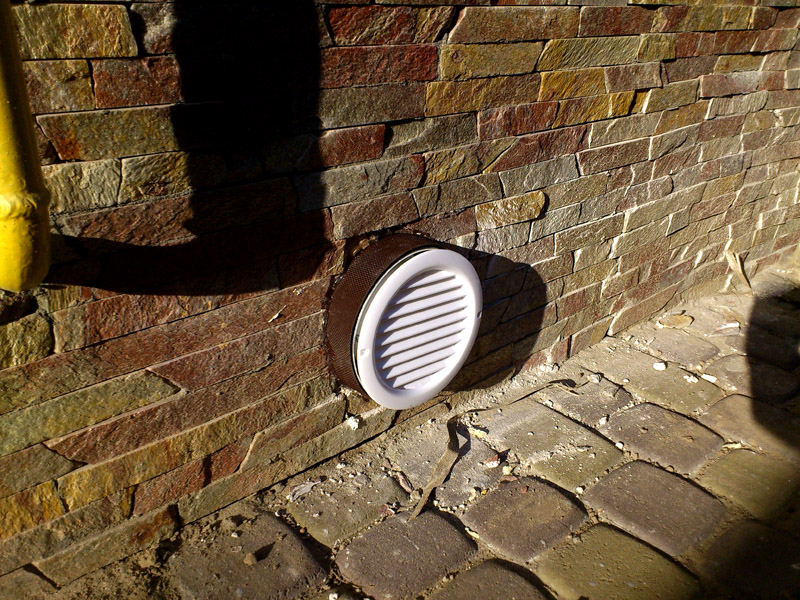



Filter elements are installed in some inlet channels to trap dust and other mechanical impurities. Such details can significantly reduce the performance of the system.
For your information! Height ventilation pipes not regulated by SNiP. In practice, however, chimney standards can be applied. If the above rules are followed, obstacles to the free movement of air in the right direction with different wind direction and strength will be minimized.
Why do you need a forced ventilation system in a private house
In the systems discussed above, the movement of air is carried out due to various atmospheric pressure at different heights, when heated, under the influence of gusts of wind. The main advantage of these techniques is energy independence. However, they are all overly susceptible to all sorts of external factors. The task becomes more complicated as the height of the channels increases.

In order to ensure the necessary performance in any conditions, impellers with electric drives are used. different types.


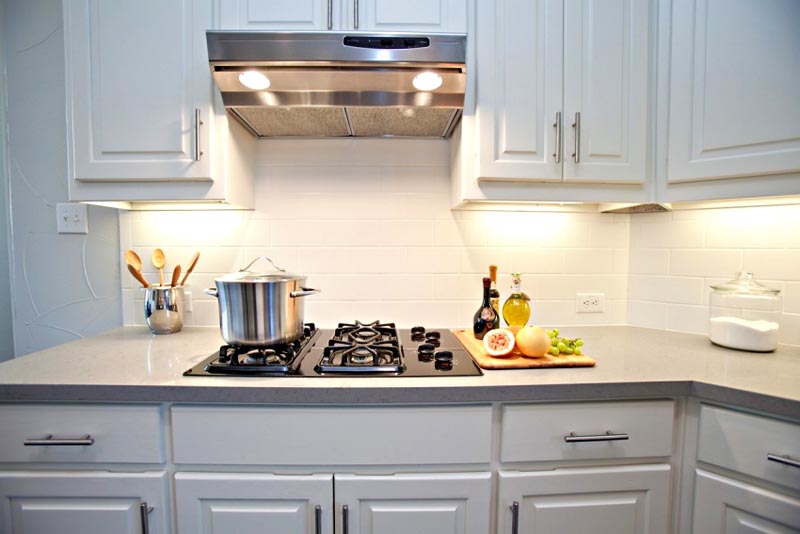


This figure shows the centralized equipment of the object. Here, one power unit is used, which provides air supply and output. When installing sensors and control devices, the ventilation performance of individual rooms is changed. When combined with air conditioners, heating, they solve the problem of maintaining comfortable temperature conditions.

What schemes are used to organize effective ventilation in a private house
In practice, various combinations of natural and forced methods are used. To clarify the requirements of the terms of reference, it is necessary to study in detail the typical design solutions.

Supply ventilation in a private house: the principle of operation
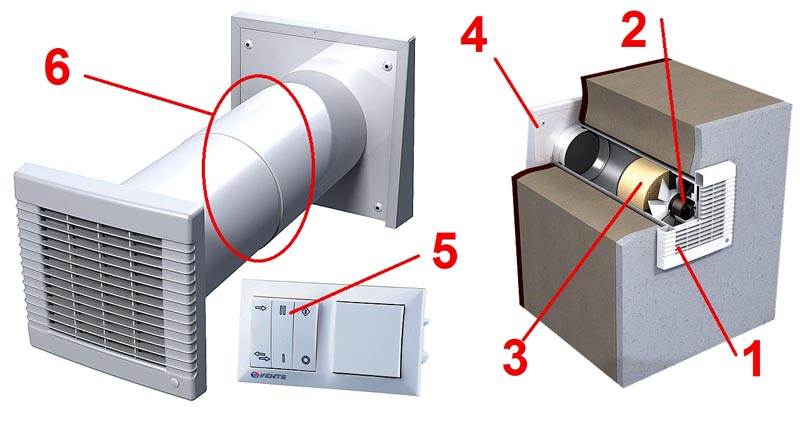
With this kit, you can provide a metered supply of purified air to the room:
- To protect against the penetration of insects and leaves, there is a removable grill (1).
- Air movement is provided by an electric fan (2). The rotation speed of the rotor of this model is regulated by the switch (5) in steps.
- The insert (3) made of porous material retains small mechanical impurities.
- The inner grille (4) has a decorative function.
- The expandable tube design (6) allows for precise installation, taking into account certain wall thicknesses.
In the standard definition, a supply system is a system that is capable of changing the air temperature. Therefore, full-fledged devices of the appropriate type are equipped with heating elements, combined with air conditioners.


In such devices, multi-stage speed controllers, fine filters, and heaters are installed. Built-in electronics allows you to set custom operating modes for time, temperature. Operation is simplified with remote controls.



Modern systems combined with intelligent control and management systems of the “smart home” category. This simplifies the optimization of equipment operation, allows you to organize remote remote control of equipment via the Internet.
Features of exhaust ventilation in a private house
This system is needed for the effective removal of exhaust and polluted air from the premises. With its help, gas combustion products are removed from the atmosphere of residential real estate during the operation of cooking and heating equipment.

In this example, you can explore the solution to a typical problem in a separate functional block. This system removes wet air from the bathroom and smells from the toilet using forced ventilation. Electric drives are connected to the power supply separately. The toilet has a timer. It turns off the fan automatically after the desired time interval after turning off the lighting in the room. The reverse air movement is blocked by two valves. Pollution is removed outside through a common shaft.

In this variant, one should not excessively increase the length of the side channels, apply several turns. This will increase the resistance, so a more powerful fan will be needed.
For your information! In such systems, there are significant temperature fluctuations on small area tracks. This stimulates the appearance of moisture on the inner surfaces. To prevent condensate from penetrating into the premises, a slight slope towards the street should be made for free flow.
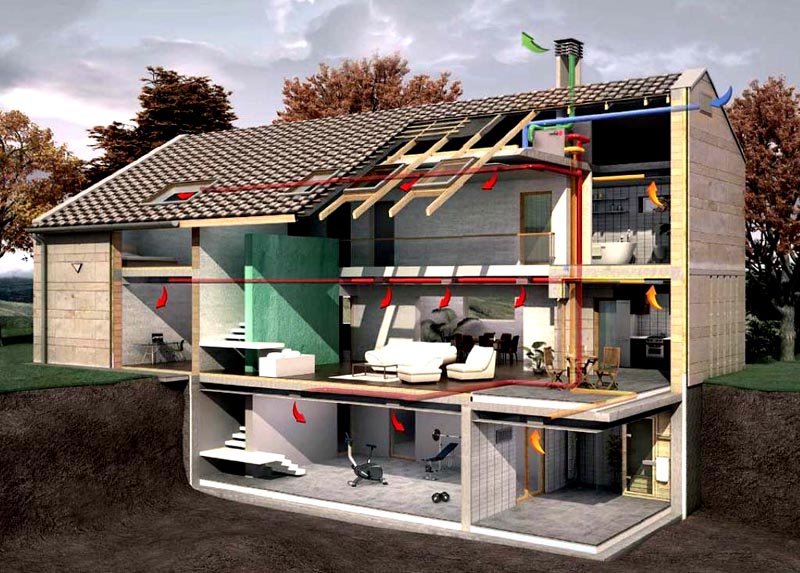
On a three-dimensional layout, it is easier than on a flat drawing to study the relative position of engineering systems, decorative and functional elements of the house. This approach minimizes errors. In particular, for better ventilation, the inflow and exhaust are installed diagonally in the room. Space is freed up near the ventilation openings so as not to create artificial obstacles to the movement of air.
Expanded possibilities of high-quality supply and exhaust ventilation in a private house
As the name suggests, this system provides fresh air and exhaust air. An integrated approach makes it possible to economically use energy resources and perform the assigned tasks in a coordinated manner.

The principle of operation of this technique is clear from the figure. The heat exchanger combines two channels (exhaust and supply) without mixing. This solution helps to pre-heat/cool the air without using additional energy sources.
Related article:
Helps ensure adequate access to fresh air. This article discusses the principles of operation, factory models, manufacturing technology and installation of equipment on their own.

Below are other important facts worth noting:
- It is perfectly acceptable to use several dependent and autonomous systems. The example above shows that it is better to equip the garage attached to the house with separate ventilation.
- In some rooms it is more convenient to mount individual sets of equipment. Breezer can be installed in an hour. It does not need to be connected to a central ventilation duct. All work is carried out without making changes to the decoration of the room.
- When assessing the noise level of channel installations, experienced specialists recommend taking measurements in the area of the inlet and outlet, near units equipped with electric drives. Manufacturers indicate in the accompanying documentation the acoustic power or sound pressure. For comparison, you need to take the same parameters.
- The power of regular heating elements exceeds 3 kW. This allows you to quickly raise the temperature at any time of the year. But you need to make sure that the wiring and other network components are designed for the appropriate loads. If necessary, install a liquid heat exchanger.
- Automation parameters must be checked carefully. You should make sure that the remote control is easy to use, easy to set up. In addition to the typical change in fan speed, the ability to set an individual time schedule is useful. At night, for example, reduce the temperature, the intensity of ventilation.
- It is useful to save user settings in memory. Care is simplified if there is a differential type pressure sensor. This device measures pressure changes before and after the filter. An increase in reading difference will indicate excessive contamination. In cheap modifications, “on time” signaling devices are installed, which do not provide high control accuracy.
- Self-diagnostics using software and electronic tools will help you find out about equipment problems in a timely manner. Additional convenience is provided by user notification with forwarding of messages to a smartphone, or other mobile device, desktop computer.
- In serial household equipment, G4 filters are installed, which are capable of poplar fluff, bird feathers, and other large impurities. If necessary, instead of it, or sequentially install elements with small channels. Retention of particles with sizes less than one micrometer is acceptable. It must be remembered that such modernization will increase the load on the ventilation units.
When developing project documentation, it is necessary to separately study the issues of future operation. Ventilation equipment will have to be serviced. It is necessary to exclude situations when, in order to inspect and perform routine maintenance, it is necessary to dismantle parts decorative finishes, building structures. For this reason, it is more convenient to place fans, filters and other system components in a special technological room. Such a solution will simplify the creation of effective noise isolation of the ventilation unit.
What to consider when equipping individual rooms
During the distribution of flows, it is necessary to ensure the initial penetration of air from the street into the living room, bedroom, and other living rooms. From there, he is sent to the technical rooms, to the kitchen, to the closets, to the bathroom. This solution will create excess pressure in places of permanent residence, which will prevent unpleasant odors and other contaminants from getting there.
For your information! According to the current standards, “permanent stay” rooms are rooms in which people stay for more than 6 hours in one day or from 2 hours continuously.
Ventilation in the kitchen in a private house: a rational solution to complex problems
In this room, the temperature varies over a wide range, . The process of cooking is accompanied by the appearance of odors, air pollution hazardous to health and persistent impurities. It is necessary to take into account not only the intensity, but also the high frequency of various negative impacts.
It is also necessary to remember the peculiarities of working with kitchen appliances. If an electric hob is installed, an air exchange of at least 60 cubic meters should be ensured. per person per hour. When installing a gas stove, this standard is increased by 50% (up to 90 cubic meters).
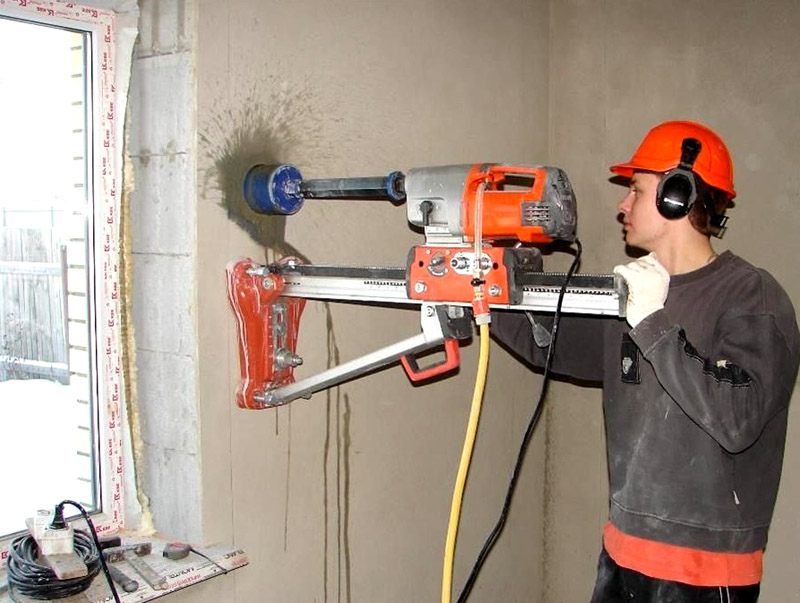
Related article:
There are many ways to ensure a healthy environment. If you install the supply valve in the wall - the problem will be solved quickly. In a special publication, we will consider how to correctly select and mount it.



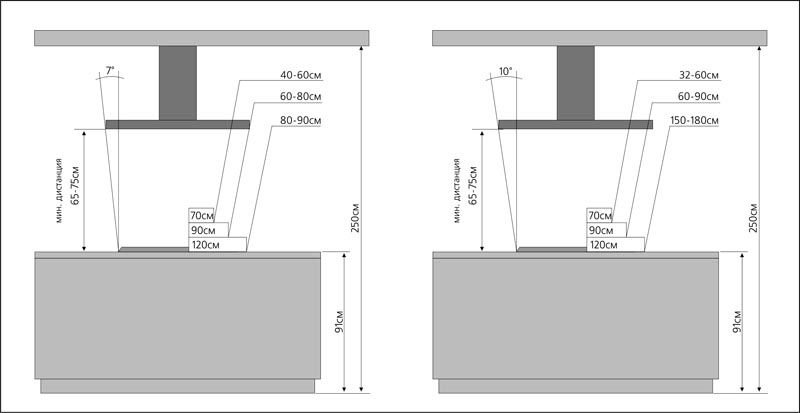
For your information! The minimum distance from the hood body to the gas/electric stove must be at least 65/75 cm respectively.

Principles of coordinated operation of the two systems:
- Rice. "A". Initially, the design of the house provides only natural ventilation using a hole (2). It can be seen that part (1) will reduce the cross section of the common channel (3) after installation.
- On Fig. "B" shows the operation of the non-return valve (5), which is installed behind the decorative grille (4). When the hood fan is turned on, it closes, blocking the movement of air in the opposite direction.
- The following figure "C" shows the operation of natural ventilation.



Table hoods descend inside cabinet furniture when turned off. They can be connected to ventilation shafts according to the standard scheme, from above. But if necessary, the corresponding channels are created in the floor screed. The latter option is associated with significant changes in architectural designs. It is used in the construction of a house, during a major overhaul.
To maintain high performance, the following details must be taken into account when designing the exhaust connection:
- It's not hard to work with. But these products create more resistance to air flow compared to the smooth walls of the channels.
- The cross section of the duct is selected in accordance with the manufacturer's instructions. It should not be less than the specified value.
- When laying the route, it is necessary to prevent flattening of flexible pipes and other significant deformations. The number of turns should be minimized.
An approximate calculation of the required extraction capacity can be made using the formula P = (L x W x H) x 12 x 1.25, Where
- P – maximum amount air removed from the premises per hour in cubic meters;
- D,W And IN- length, width and height of the room in meters;
- 12 – standard correction factor;
- 1,25 - an additional power reserve, which is useful for quickly removing fumes from burnt food.
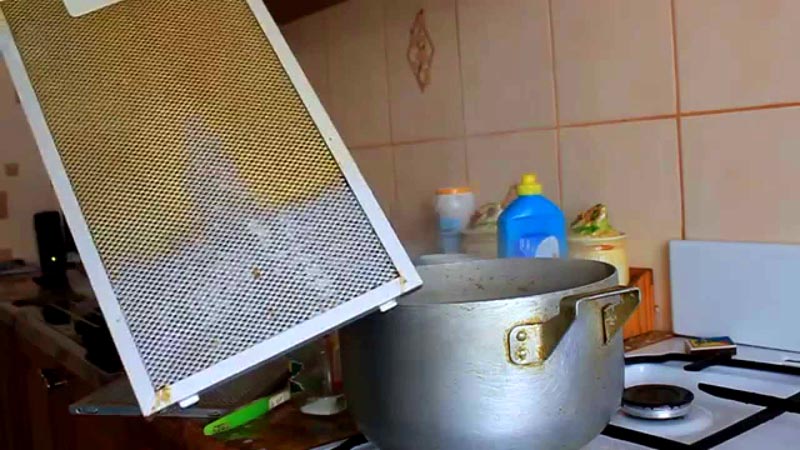
This operation can be performed safely with steam over boiling water. Also use special detergents. To remind you of routine procedures, hoods are equipped with electronic timers with sound and light alarms.

Here the hood is supplemented with air conditioning. This technique is more expensive than standard models. But it is able to maintain the temperature mode set by the user in the room.

Such equipment acts as a filter. It helps to trap contaminants. As a rule, additional elements with carbon fillers are used. These sorption technologies help to remove the smallest impurities and unpleasant odors. However, in any case, it is necessary to ensure the operation of the ventilation system. In this embodiment, an existing shaft is used. To improve performance, forced mechanisms are installed in the input (exhaust) path.

Related article:
To find out, it is necessary to supplement with deep thematic knowledge. This article contains information that will help you make a comprehensive analysis and make the right decision to purchase a particular product.
How to create good ventilation in the toilet and bathroom
To calculate the needs of these parts of the property, the following air exchange standards are used in cubic meters. in an hour:
- 25 - for each individual room;
- 50 - for a combined bathroom.
Insufficient ventilation in the bathroom in a private house contributes to the appearance of mold, fungal colonies. Except for the unsightly appearance the composition of the atmosphere deteriorates. Some microorganisms provoke the occurrence of diseases dangerous to health, therefore, appropriate preventive measures can be called mandatory. Of course, we must not forget about peeling paint and damage to other decorative coatings, intensification of destructive corrosion processes.
Air can be supplied here from living rooms, corridors. If there are not enough available slots, through holes with plastic inserts are made in the door leafs.


The possibilities of natural ventilation for such premises are not enough. Therefore, more efficient forced systems are used. The choice of fan is made taking into account individual conditions. Above are the minimum regulatory requirements. They will not be enough if you often take a shower when a lot of people live in the house. As in the case of the kitchen, it is better to install a sufficient power margin here.
For your information! For an approximate calculation, you can use the above formula with a factor of "5" instead of "12".

The walls are reinforced with a piece of plastic pipe. The installation site is chosen at a distance from plumbing fixtures in order to prevent accidental splashes on the body of the equipment.



When choosing a technique, you need to pay attention to the features of modern models:
- The grille and housing made of durable polymers are not damaged in conditions of high humidity and temperature changes.
- The aerodynamic impeller with a large number of blades creates a strong air flow at relatively low speeds, with minimal noise.
- vibrations from electric drive effectively extinguish damping inserts.
- Rotor supports on ball bearings are designed for long-term intensive operation.
- Good tightness of the joints of individual parts prevents moisture from penetrating inside.
- Light weight makes installation easier.
- Some models additionally, or as standard, are equipped with check valves.
For your information! When choosing a fan for a small room, pay special attention to the noise level. A value of 35 dB and below can be called quite acceptable. If the manufacturer has specified less than 25 dB, the sound of the operating electric drive will not be heard at a distance of several meters.
Special ventilation in the basement of a private house: reliable protection against mold and dampness
Requirements for the design of the system are formulated taking into account the intended purpose of the premises in this part of the building. With an area of up to 40-50 square meters. in a low-rise building, it is enough to install natural ventilation.
This figure can be used to explain the main parameters of the system:
- The inlet is closed with a grate from the penetration of rodents.
- The opening of the supply pipe in the basement is mounted at a distance of 20-30 cm from the floor level.
- The hood is installed diagonally. The pipe entrance is 20 cm below the ceiling.
- A plug closes the channel in winter, preventing the penetration of cold air.
- The "umbrella" on the roof protects against precipitation entering the system.
Related article:
In the review, we will talk about how the air circulation scheme in such rooms should be arranged, as well as what types of it are. Indeed, in the garage, not only the removal of gases is necessary, but also the maintenance of humidity at the required level - its excess reduces the life of the car.
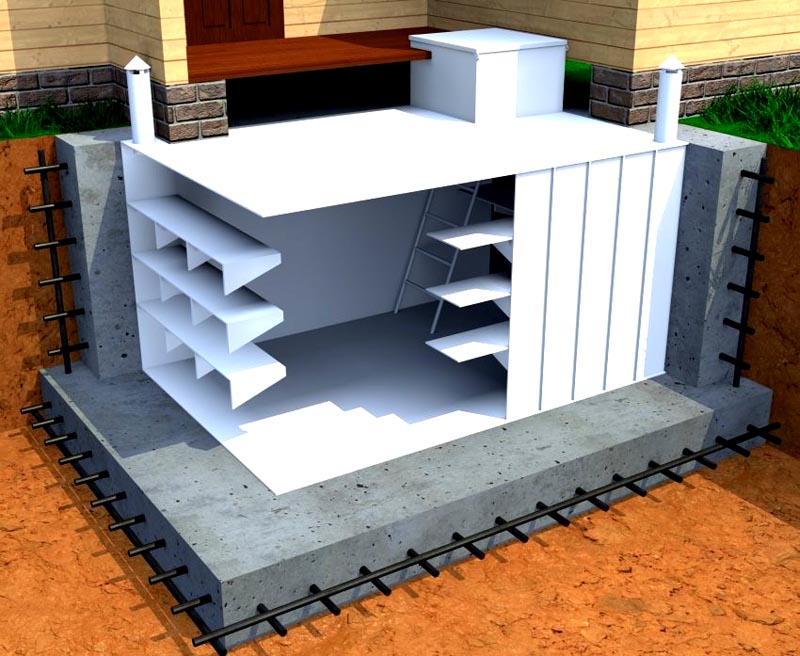
The examples given are suitable for organizing suitable conditions for storing vegetables, conservation, garden tools, and consumables in the lower part of the building.
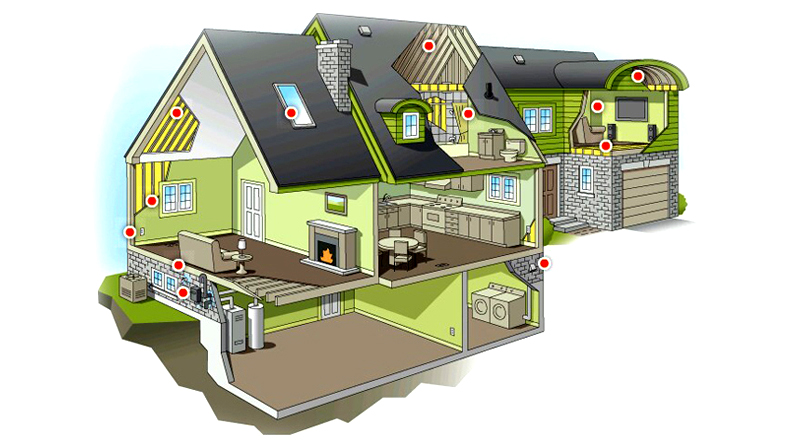
In this case, standard norms for living rooms are used to calculate the system and individual parts. They make an additional supply for the gym, shower room, kitchen block. Productivity is increased by forced ventilation.

Important! To figure out how to make ventilation in the basement of a private house, you must first create a list of requirements, taking into account the characteristics of individual rooms. The mode of operation also matters.
Mandatory requirements for ventilation of the boiler room
The parameters of the ventilation system when installing gas equipment are precisely set by the current building codes and regulations:
- The minimum supply capacity is determined by the characteristics of the boiler. The cross-sectional area of the inlet channel is normalized (in cm square per 1 kW of heating equipment power):
- 8 or more if the inflow is made directly from the street;
- more than 30 when the air comes from adjacent rooms.
- An exit hole is made on the ceiling. It is connected to the central ventilation shaft of the house.
- In addition to the main one, it is necessary to install a second channel (lower by 25-30 cm) for routine inspections and removal of contaminants.
- The volume of the room is made not less than 7.5 cubic meters. with a total power of heating equipment up to 30 kW.
Suitable ventilation for a private home should provide at least three complete air changes per hour.

Important! The calculation of the ventilation of the boiler room must exactly comply with the current SNiP standards. If it is too difficult to do it on your own, contact the experts for help. It should be remembered that non-compliance with the law is punishable by significant fines. Reworking incorrect designs will cost more compared to the cost of professionally preparing design documentation.
Features of attic ventilation

On keeping here high temperature all year round it will take too much energy. Instead, high-quality insulation of ventilation ducts is used.

These elements are installed at the same distance from the eaves, side faces, ridge. The distance between them is made more than 1.5 meters. Sufficient attention should be paid to the aesthetic characteristics of the windows so that they do not disturb the harmony of the appearance. The total dimensions of such holes must be at least 1/500 in relation to the total area of the attic space.
For your information! A heated attic in a private house is ventilated using the usual norms for residential premises.
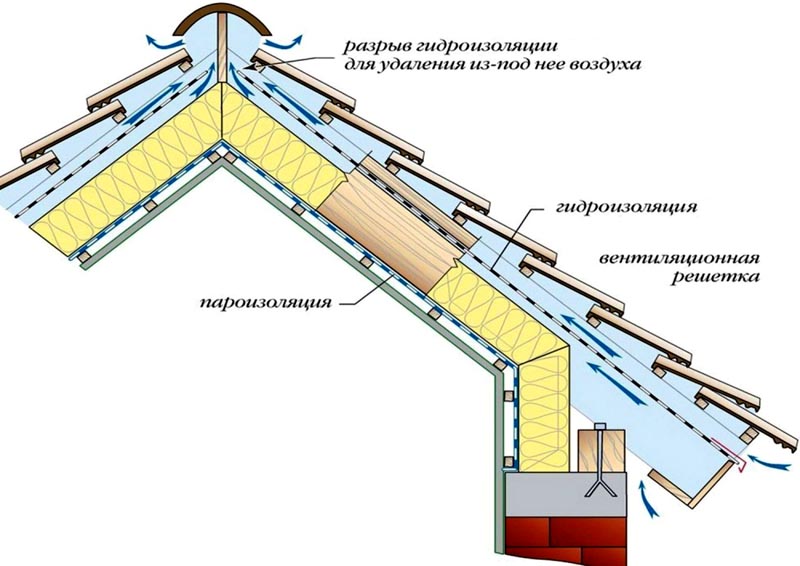
How does the ventilation system of the sewerage system perform its functions in a private house
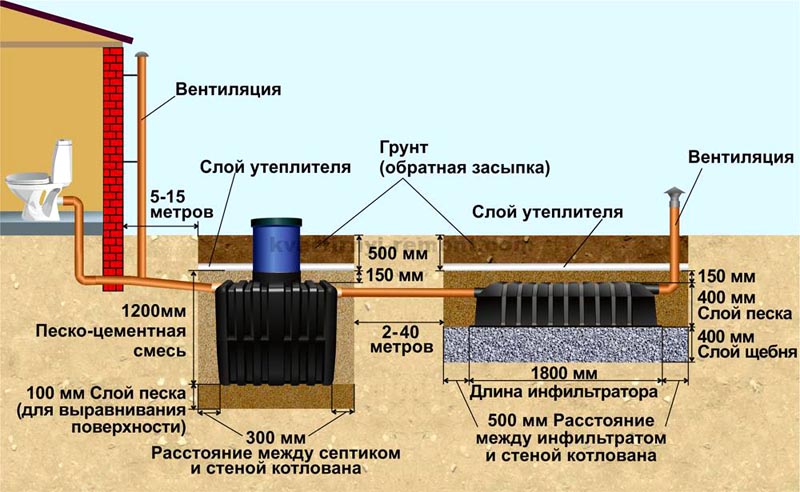
The sewer ventilation scheme in a private house shows that the number of output channels is determined design features sewer system. Here one pipe is installed in front. The second is in the far part of the infiltrator.

If it is not possible to install ventilation ducts on all risers, only the far part is connected to the outlet to the roof. The deflector increases efficiency of removal of polluted air.
In this figure, the following details are indicated by numbers:
- chimney (1) connected to heating equipment;
- "backlash channel" (2);
- wooden (3) and cast iron (4) cover;
- outlet section of the ventilation system (5);
- brickwork (6);
- clay castle (7), preventing the penetration of contaminants into the soil.
Basement ventilation: important nuances
If this part of the building is not in use due to its low height, or for other reasons, appropriate protective measures are necessary. The organization of good ventilation of the foundation in a private house without a basement prevents damage to the wooden parts of the structures by rotting processes, the appearance of fungal spores dangerous to humans.

For your information! Installation of ventilation of the basement floor of a private house is necessary for the timely removal of radon. This radioactive gas is not detected by the human senses.
Normalization of the humidity level in the pool with the help of productive ventilation
This information will help to formulate the correct requirements for ventilation of the respective premises:
- Experts recommend not to increase the water content in the atmosphere above the level of 14 g per kg of air.
- normal range relative humidity from 40 to 655.
- If the surface temperature is below the dew point, intense condensation occurs. Such processes, in particular, can be observed on the outer walls of air duct pipes.
- To prevent drafts and the resulting respiratory diseases, the air flow rate should not exceed 0.15 m per second.
- Increasing the pressure in the room (special regulation of supply and exhaust) will prevent the ingress of chlorine chemical compounds into other rooms. If this backwater is set to more than 15-25 Pa, there may be obstacles when opening the doors.

How to make ventilation in a private house: preparation of calculations, project documentation
During the calculation of ventilation in a private house, professionals determine the following important parameters:
- The performance of the air exchange system in cubic meters. in an hour. It is determined for each functional room separately, based on the current standards and operating features.
- Further specify the characteristics of the individual components of the air distribution network:
- channel sizes;
- switchgear dimensions;
- resistance to air movement;
- power of heating units;
- consumed electrical energy.
- The data obtained is used to select a suitable air handling unit.
For your information! In order not to figure out how to properly ventilate a private house, you can take the help of experienced professionals. When buying equipment, such services are provided free of charge by specialized stores.
The materials posted in this article will help you understand how to make a hood in a private house on your own. It should be noted that in any case, personal preferences are of decisive importance. For a demanding user, the volumes of fresh air that are given in building codes may not be enough.
Do-it-yourself ventilation schemes in a private house: an overview of typical solutions



Creating high-quality ventilation in a private house with your own hands
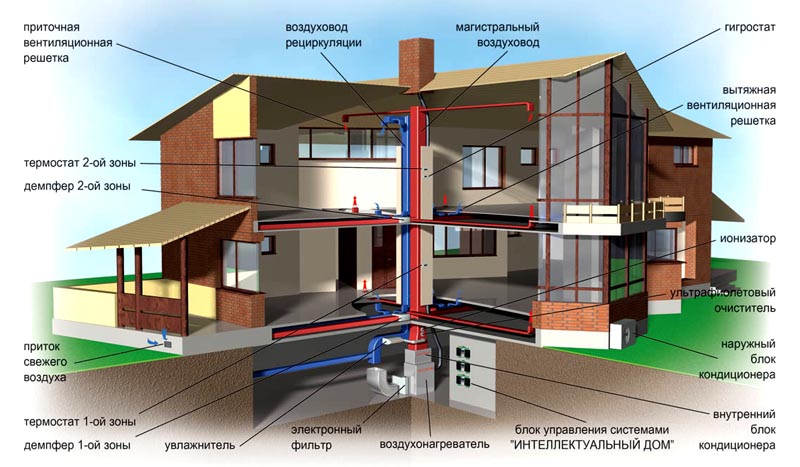
Similar supply and exhaust ventilation can be created by hand. But to implement large-scale plans, you will have to study design issues on professional level. You will need knowledge on how to properly configure the joint work of all engineering systems in the house.
Proper distribution of labor and other resources will help to solve difficult problems without mistakes. The performance of individual works and the most difficult stages can be entrusted to specialized specialists. Some parts supply ventilation you can install it yourself without the involvement of assistants.
Proper solution of individual tasks during system installation

The installation of channels should not violate the tightness of the layers. Damage to the wiring, water and gas supply should be excluded. In order not to disturb hidden communications, they use accurate plans, phased snapshots of the construction processes. The necessary materials should be prepared in advance. Similar precautions will come in handy when installing ventilation under the floor in a private house. If possible, the tracks are installed under removable panels. suspended ceilings. Dismantling drywall and wood paneling will also not be overly difficult.
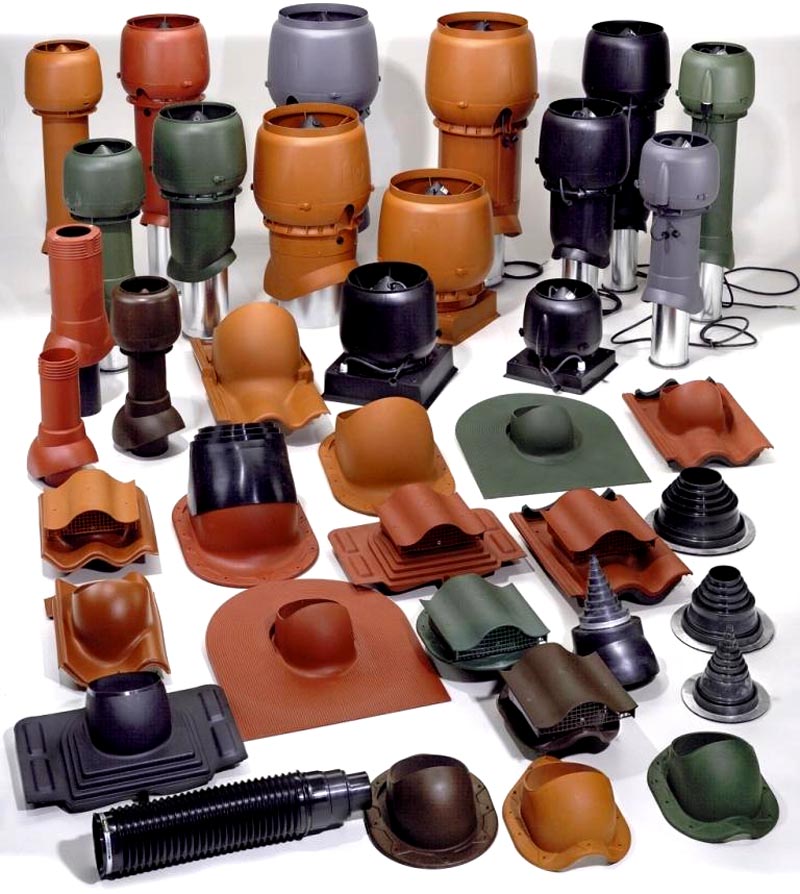

How to choose pipes and other components of the ventilation system without mistakes

With the help of such parts, a route with a complex configuration can be created quickly, without errors.
Used to clean the incoming air from contaminants. different devices. In addition to mechanical (mesh and volumetric), photocatalytic, carbon and other types of filters can be installed. Some of them perform their functions qualitatively, but do not increase the resistance to air flow.
Such products can be used if they fit in diameter. Products in this category (gray) are intended for indoor installation. Excessive heating (above +60°C), strong mechanical impacts should be prevented.

Step by step installation with comments
How to make ventilation in the house using specialized components is described in the following table:
| Photo | Working steps, explanations, comments |
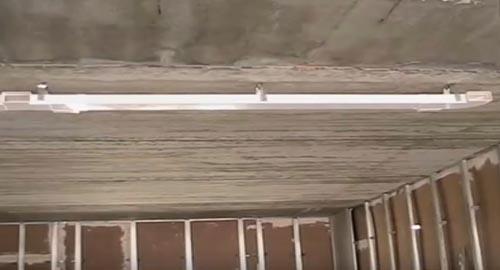 | It is convenient to use the system for work plastic air ducts. The specially reduced height helps to save free space. |
 | Such products are installed in a horizontal and vertical position. |
 | The range of manufacturers includes air ducts with different channels: round (diameter - 100; 125; 150 mm); rectangular (dimensions - 60 x120; 60 x 204 mm). |
 | Fast and accurate installation is ensured by matching the dimensions of the joined parts, a large number of various additional elements. It is not difficult to handle light products in hard-to-reach places, at height. They are connected into a single structure without special tools. They are cut to the required size with a hand saw with a canvas for wood. |
 | Before installation work, it is necessary to prepare project documentation. In accordance with the drawings, holes are made in certain places of the building structures. |
 | Next, select the necessary fittings. |
 | Tee. |
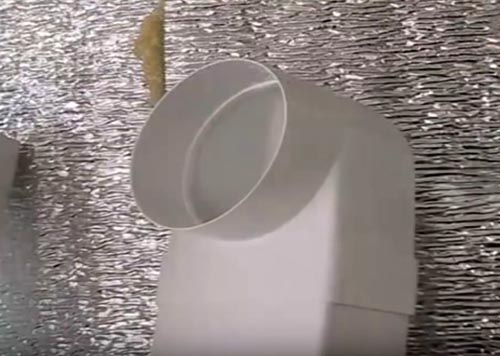 | Such a product performs the transition from a rectangular section of the channel to a round pipe. |
 | Such taps are used to change the passage of the route in different planes. |
 | To speed up the assembly of ventilation in the house with your own hands, functional modules of several elements are connected in advance. |
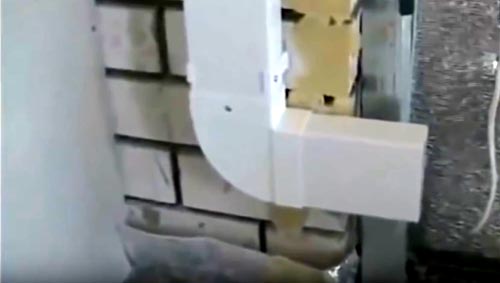 | Such blanks are mounted in the right places. Special fasteners are used to fix vertical and horizontal sections. This inlet is located taking into account the fact that a plasterboard sheathing with a decorative lattice will be installed on top. |
 | To speed up work operations, cutting to size is done using a grinder. But it is quite acceptable to use a hand tool. |
 | Connections are reinforced with self-tapping screws. |
For your information! Installation of ventilation in a private house is often accompanied by drilling holes in the outer walls to create supply channels. These complex operations are performed using diamond nozzles. For their cooling working area water is supplied, which, together with the debris, flows down, forming unpleasant stains. Such a procedure should be planned before the final finish in order to prevent additional costs for restoring the flawless appearance of the facade.
Features of a professional ventilation installation in a private house: prices, scope of work, control operations
| Assembly and other work operations | Service cost, rub. |
| Design based on 1 sq.m. floor space | 55-70 |
| Installation of flexible/rigid ducts (per 1 sq.m.) | 99-120/300-850 |
| Installation of a recovery unit with a capacity of up to 2 thousand cubic meters. at one o'clock | 8000-35000 |
| Installing a duct/roof fan | 4000-7000/3500-5000 |
| Installation and configuration of the automation cabinet | 5000-10000 |
| Departure of specialists for maintenance | 3000-6000 |

A properly selected do-it-yourself ventilation scheme in a private scrap is a reliable basis for future success. Careful preparation will allow you to choose best option for a particular structure and specific needs. An objective assessment of your own financial capabilities and installation skills will come in handy. If necessary, specialized specialists can be involved to perform individual operations. You should carefully study the technical innovations, modern materials, so as not to miss the actual advantages in the relevant market segment.
In the comments to the article - ask questions on this topic, share your experience. For a successful solution challenging tasks come in handy professional advice and knowledge of the practical implementation of similar projects.



